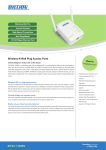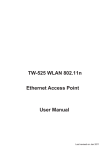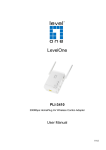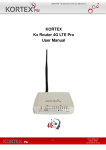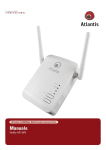Download Billion BiPAC 3100SN User manual
Transcript
BiPAC 3100SN Wireless-N Wall Plug Ethernet Access Point User Manual FW Version 1.08e-c Last revised on May. 2011 Safty Warnings 1. Do not use the adapter in high humidity or high temperature environment. 2. Do not open or repair the case yourself. 3. Avoid using this product and all its accesories outdoor. 4. Place the adapter on a stable surface. 5. Plug your Ethernet Access Point device directly to the AC outlet on the wall. It is best to avoid using extension power cable as it may possess noise filter or surge protector functions that may cause interference that may impact the performance of the device. Table of Contents Chapter 1: Product............................................................................. 1 1.1 Introduction............................................................................ 1 1.2 Features................................................................................. 2 Chapter 2: Installing the Adapter...................................................... 3 2.1 Package Content.................................................................... 3 2.2 Device Overview.................................................................... 4 2.3 Hardware Installation............................................................. 6 2.4 Connecting the Access Point................................................. 8 2.4.1 Power Connection.......................................................................8 2.4.2 LAN & Wireless Connection........................................................8 2.4.3 Product Application.....................................................................9 Chapter 3: Basic Network Installation ........................................... 10 3.1 Network Configuration.......................................................... 11 3.1.1 Configuring PC in Windows 7................................................... 11 3.1.2 Configuring PC in Windows Vista..............................................13 3.1.3 Configuring PC in Windows XP.................................................15 3.1.4 Configuring PC in Windows 2000.............................................16 3.1.5 Configuring PC in Windows 95/98/Me.......................................17 3.1.6 Configuring PC in Windows NT4.0............................................18 3.2 Factory Default Settings....................................................... 19 3.3 Internet Access Configuration.............................................. 20 3.3.1 Configuring with your Web Browser..........................................20 Chapter 4: Configuration................................................................. 21 4.1 Status................................................................................... 22 4.1.1 Status........................................................................................22 4.1.2 Statistic.....................................................................................23 4.2 LAN Setting.......................................................................... 24 4.2.1 LAN...........................................................................................24 4.3 Wireless Settings................................................................. 25 4.3.1 Basic Wireless Settings.............................................................26 4.3.2 Wireless Security/Encryption Settings......................................31 4.3.2.1 Secuirty Mode...................................................................................... 32 4.3.3 Advanced Wireless Settings......................................................34 4.3.4 Wi-Fi Protected Setup...............................................................35 4.3.5 AP Client...................................................................................37 4.3.6 Station List................................................................................38 4.4 Administration...................................................................... 39 4.4.1 System Management................................................................39 4.4.2 Firmware Upgrade....................................................................40 4.4.3 Settings Management...............................................................41 4.4.4 Restart......................................................................................42 Chapter 5: Troubleshooting............................................................. 43 Appendix: Product Support & Contact........................................... 44 Chapter 1: Product 1.1 Introduction Thank you for purchasing BiPAC 3100SN Wireless-N Wall Plug Ethernet Access Point. Your new device is an unit that extends your wireless coverage.BiPAC 3100SN can be used to bridge Ethernet devices such as modems, routers, PCs, set-top-boxes, and game consoles, allowing users to share network access via existing in-home power cabling. What's unique is that the device has an extra built-in 802.11n Access Point, enabling users to enjoy mobility, high-speed wireless connection and better coverage with no more dead zones. Just plug BiPAC 3100SN into any wall power socket, and you can easily set up a secure wireless network by pressing the Wi-Fi Protected Setup (WPS) button. Thus, the adapter can extend your wireless coverage for multimedia applications such as online games, IPTV and audio streaming from room to room. • Extended Wireless Coverage With an integrated 802.11n Wireless Access Point, the adapter can bridge wireless connections of up to 6 times the speed and 3 times the wireless coverage of an 802.11b / g network device. It supports a data rates up to 300Mbps and is also compatible with 802.11b / g equipment. • 802.11g / 802.11n Wireless AP with WPA / WPS Support With an integrated 802.11g / 802.11n Wireless Access Point, the device supported the features of Wi-Fi Protected Access (WPA-PSK/ WPA2-PSK) and Wired Equivalent Privacy (WEP) which enhance the security level of data protection and access control via Wireless LAN. The device also supports the Wi-Fi Protected Setup (WPS) standard, allowing users to establish a secure wireless network by simply pushing a button. • Rich Management Interfaces It supports flexible management interfaces with LAN and WLAN. Users can use WEB GUI through the above interfaces to configure and manage the device. • Web based GUI It supports web based GUI for configuration and management. It is user-friendly • Firmware Upgradeable Device can be upgraded to the latest firmware through the WEB based GUI. 1 1.2 Features • Provides physical layer data rate of up to 300Mbps over wireless • Deliver up to 6 times speed and extended 3 times wireless coverage of a 802.11b/g network device • WPS (Wi-Fi Protected Setup) for easy setup • Auto channel select • Supports Triple Play applications such as IPTV, VoIP and high-speed Internet access • Supports 10/100 BaseT Ethernet • Ideal for residential users 2 Chapter 2: Installing the Adapter 2.1 Package Content • BiPAC 3100SN Wireless-N Wall Plug Ethernet Access Point • Quick Start Guide • CD (containing user manual and QSG) • Ethernet (CAT-5 LAN) cable 3 2.2 Device Overview WLAN LED Clip Socket Power LED ETH LED WPS Button Ethernet Port Reset Button Power Plug The Description of each labeled part is described in the table below. WLAN LED ETH (Ethernet Link/Act) LED Lit green when the wireless function is enabled. Blinking when data is transmitted or received via WLAN. Blinking quickly when WPS is proceeded. Lit green when the device is power on. Lit off when power is off. Lit green when connected to an Ethernet device. Blinking when data is transmitted or received via Ethernet port. WPS Button Push this button to trigger Wi-Fi Protected Setup function. Reset Button Press this button for more than 2 seconds until WLAN LED blinking and then release this button to reset device to factory default settings. Ethernet Port Connect the Ethernet Access Point device with an Ethernet device (e.g. computer, router, hub/switch, IP pone, IPTV set-top-box, gaming consoles…), using the RJ-45 Ethernet cable included. Plug into an AC outlet for power supply. Power LED Power Plug / AC Power Cord Clip Socket Install the clip into this socket. Note: Please DO NOT remove or disassemble the socket clip frequently as this may cause serious damage on your Ethernet Access Point device. 4 5 2.3 Hardware Installation Refer to the following diagrams and instructions to install the clip with BiPAC 3100SN: Example 1: EU clip • Please check the lock instruction on your clip. • If you got the “Triangle Lock”, refer to right diagram. 6 Example 2: UK clip • Please check the lock instruction on your clip. • If you got the “Circle Lock”, refer to right diagram. 7 2.4 Connecting the Access Point It is easy to connect BiPAC 3100SN simply by performing the following instructions: 2.4.1 Power Connection Plug BiPAC 3100SN into the wall outlet/socket. 2.4.2 LAN & Wireless Connection Connect the supplied RJ-45 Ethernet cable to the Ethernet port on BiPAC 3100SN and the other side to the device’s Ethernet interface. You can enable wireless function to connect to the Wi-Fi devices through WPS configuration interface or by pushing the WPS button of your 3100SN. Note: For WPS configuration please refer to Wi-Fi Protected Setup section for more detail description. 8 2.4.3 Product Application 9 Chapter 3: Basic Network Installation The Ethernet Access Point can be configured through your web browser. A web browser is included as a standard application in the following operating systems: Linux, Mac OS, Windows 98/NT/2000/ XP/Me/Vista/7, etc. The product provides an easy and user-friendly interface for configuration. Please check your PC network components. The TCP/IP protocol stack and Ethernet network adapter must be installed. If not, please refer to your Windows-related or other operating system manuals. There are ways to connect the device, either through an external repeater hub or connect directly to your PCs. However, make sure that your PCs have an Ethernet interface installed properly prior to connecting the device. You ought to configure your PCs to obtain an IP address through a fixed IP address that must be in the same subnet as the device. The default IP address of the device is 192.168.1.253 and the subnet mask is 255.255.255.0 (i.e. any attached PC must be in the same subnet, and have an IP address in the range of 192.168.1.1 to 192.168.1.252). If you encounter any problem accessing the Ethernet Access Point web interface it is advisable to uninstall your firewall program on your PCs, as they can cause problems accessing the IP address of the device. Users should make their own decisions on what is best to protect their network. Please follow the following steps to configure your PC network environment. 10 3.1 Network Configuration 3.1.1 Configuring PC in Windows 7 1. Go to Start. Click on Control Panel. 2. Then click on Network and Internet. 3. When the Network and Sharing Center window pops up, select and click on Change adapter settings on the left window panel. 4. Select the Local Area Connection, and right click the icon to select Properties. 11 5. Select Internet Protocol Version 4 (TCP/IPv4) then click Properties. 6. In the TCP/IPv4 properties window, click Use the following IP address and Use the following DNS server address radio buttons. Then click OK to exit the setting. 7. Click OK again in the Local Area Connection Properties window to apply the new configuration. 12 3.1.2 Configuring PC in Windows Vista 1. Go to Start. Click on Network. 2. Then click on Network and Sharing Center at the top bar. 3. When the Network and Sharing Center window pops up, select and click on Manage network connections on the left window column. 4. Select the Local Area Connection, and right click the icon to select Properties. 13 5. Select Internet Protocol Version 4 (TCP/IPv4) then click Properties. 6. In the TCP/IPv4 properties window, click Use the following IP address and Use the following DNS server address radio buttons. Then click OK to exit the setting. 7. Click OK again in the Local Area Connection Properties window to apply the new configuration. 14 3.1.3 Configuring PC in Windows XP 1. Go to Start > Control Panel (in Classic View). In the Control Panel, double-click on Network Connections 2. Double-click Local Area Connection. 3. In the Local Area Connection Status window, click Properties. 4. Select Internet Protocol (TCP/IP) and click Properties. 5. Click Use the following IP address and Use the following DNS server address radio buttons. 6. Click OK to finish the configuration. 15 3.1.4 Configuring PC in Windows 2000 1. Go to Start > Settings > Control Panel. In the Control Panel, double-click on Network and Dial-up Connections. 2. Double-click Local Area Connection. 3. In the Local Area Connection Status window click Properties. 4. Select Internet Protocol (TCP/IP) and click Properties. 5. Click Use the following IP address and Use the following DNS server address radio buttons. 6. Click OK to finish the configuration. 16 3.1.5 Configuring PC in Windows 95/98/Me 1. Go to Start > Settings > Control Panel. In the Control Panel, double-click on Network and choose the Configuration tab. 2. Select TCP/IP > NE2000 Compatible, or the name of your Network Interface Card (NIC) in your PC. 3. Click Specify an IP address radio button. 4. Click OK to finish the configuration. 17 3.1.6 Configuring PC in Windows NT4.0 1. Go to Start > Settings > Control Panel. In the Control Panel, double-click on Network and choose the Protocols tab. 2. Select TCP/IP Properties. Protocol and click 3. Click Specify an IP address radio button. 4. Click OK to finish the configuration. 18 3.2 Factory Default Settings Before configuring your adapter, you need to know the following default settings. Web Interface (Username and Password) Username: admin Password: admin The default username and password are “admin” and “admin” respectively. Device LAN IP settings IP Address: 192.168.1.253 Subnet Mask: 255.255.255.0 19 3.3 Internet Access Configuration To configure this device for internet access, you must have IE 5.0 / Netscape 4.5 or above installed on your computer. There is basically one way to configure your device before you are able to connect to the internet: Web Interface. Configuration of this method will be discussed in detail in the following section. 3.3.1 Configuring with your Web Browser Open your web browser, enter the IP address of your Ethernet Adapter which the default is 192.168.1.253, and click “Go”. A user name and password window prompt will appear. The default username and password are “admin” and “admin”. Congratulations! You are now successfully logon to the Wireless-N Ethernet Access Point! If the authentication succeeds, the homepage will appear on the screen. 20 Chapter 4: Configuration Once you have logged on to your adapter GUI via your web browser, you can begin to configure the device according to your needs. On the configuration homepage, the left navigation pane provides the links to different setup pages. They are: ♣♣Status (Status / Statistic) ♣♣LAN Setting (LAN Setup) ♣♣Wireless Settings (Basic / Security / Advanced / WPS / AP Client / Station List) ♣♣Administration (Management / Firmware Upgrade / Settings Management / Restart) ● Each of these setup pages will be discussed in detail in the following sections. 21 4.1 Status 4.1.1 Status ● System Information Model Name: Displays the model name. Firmware Version: Displays the firmware version for this device. System Up Time: Records system up-time. Home URL: Displays the Internet address for vendor. Click to open the home page of Billion website. ● LAN LAN IP Address: The current IP on this device. LAN Netmask: The current subnet mask on this device. Note: Click the LAN IP Address or LAN Netmask link to change the settings . LAN MAC Address: The MAC address of the device. ● Wireless LAN WLAN Service: Status of the WLAN connection. SSID1: A unique name used to identify the wireless LAN to which a user wants to connect. Channel: The current status in WAN interface. Note: Click the WLAN Service, SSID or Channel link to change the settings. 22 4.1.2 Statistic ● Memory Memory total: Displays the total memory size of the device (in bytes). Memory left: Displays the amount of memory left (in bytes). ● LAN LAN Rx packets: Displays the number of received packets. LAN Rx bytes: Displays the received packet traffic (in bytes). LAN Tx packets: Displays the number of transfered packets. LAN Tx bytes: Displays the transfered packet traffic (in bytes) 23 4.2 LAN Setting 4.2.1 LAN ● IP Address: Enter the preferred IP address. Default is 192.168.1.253. ● Subnet Mask: Enter the preferred subnet mask. Default is 255.255.255.0. ● LAN2: This function enables the creation of multiple virtual IP interfaces for this device. It helps to connect two or more local networks to the ISP or remote node. In this case, an internal device is not required. Default setting is Disable. If you want to active IP Alias function, please select Enable. ● LAN2 IP Address: Specify an IP address for this virtual interface. ● LAN2 Subnet Mask: Specify a subnet mask for this virtual interface. ● UPNP: UPnP offers peer-to-peer network connectivity for PCs and other network devices, along with the feature to control data transfer between devices. Default is Disable. ♣♣Enable: Select to activate the device’s UPnP function. ♣♣Disable: Select to inactivate the device’s UPnP function. ● Click Apply to save the changes or Cancel to recover the default setting. 24 4.3 Wireless Settings When you click this item, the column will expand to display the sub-items that will allow you to configure your wireless settings. You will see the following five items: ● Basic ● Security ● Advanced ● WPS ● AP Client ● Station List The function of each configuration sub-item is described in the following sections. 25 4.3.1 Basic-Basic Wireless Settings Wireless Network ● Wireless Service: Default setting is Enable. If you do not have any wireless, select Disable. ● Wireless Mode: The default setting is 11b+g+n mixed mode. You can adjust the wireless mode depend on your system or enviornment. ● SSID1: The SSID is the unique name of a wireless access point (AP) used to distinguish one from another. For the security purpose, you should change the default SSID to a unique ID name that is difficult to guess. Make sure your wireless clients exactly have the SSID as the device in order to connect to your network. Note: It is case sensitive and can be up to 32 characters. 26 ● Multiple SSID Service: You can select Disable,or 1, 2, 3 Extension SSID to be available at the same time. There are totaly four SSID extensions for you to set. ● Multiple SSID isolation: If you enable this function, each SSID can not forward packet each other. ● Client Isolation: The selection of SSIDs will depend on the Multiple SSID Service. Select each SSID, ranging from SSID1, SSID2, SSID3 and SSID4 and set their individual configurations. If you tick the check box, the wireless client that connected the SSID can not forward the packet each other. ● Hide SSID: If you want to hide your SSID, you can enable it. The defult setting is disable. ● Country Region: There are seven Country Regions to be chosen, including North America, Europe, France, etc. The Channel Frequency will be different based on this setting. ● Channel (Frequency): Select the wireless channel ID that you would like to use. Note: Wireless performance may degrade if the selected channel ID is already being occupied by other AP(s). ● Channel Bandwidth: Select either 20 MHz or 20/40 MHz for the channel bandwidth. The higher the bandwidth the better the performance will be. ● BSSID: Displays the MAC address of the device. 27 Wireless Distribution System (WDS) It is a wireless access point mode that enables wireless link and communication with other access points. It is easy to install simply by defining the peer’s MAC address of the connected AP. WDS takes advantage of the cost saving and flexibility which no extra wireless client device is required to bridge between two access points and extending an existing wired or wireless infrastructure network to create a larger network.The diagram below demonstrates the application of WDS. Be sure that the connected devices should be in the same channel. Configuration of WDS Before configuring WDS, be sure that all devices should be in the same channel. Default setting is Disable. You can enable the WDS functionality and select one of the 3 WDS Modes to build the network connection: ● Lazy Mode ● Bridge Mode ● Repeater Mode Lazy Mode ● Lazy Mode: Select "Lazy Mode" from the WDS Mode drop-down menu. In this case, the device can be functioned as AP and Bridge. The AP MAC Address of WDS peers can be auto-detected. Please note that you are not allowed to set each AP to Lazy mode. It indicates that there is at least one AP can not be set in Lazy mode and filled the AP MAC address list. ● Wireless Security: This filed will display the encryption type in which you will set in WEP Keys fields (Please resfer to Wireless Security/Encryption Settings section after setting up the WDS Mode). 28 Bridge Mode In Bridge Mode, AP will not send beacon out and deal with probe request packets, so that wireless client will not be possible to connect with this device. The device can use complete bandwidth of WDS connection. ● Step 1: If you want the device to be a bridge, select Bridge Mode from the drop-down menu. ● Step 2: Fill in the blank with MAC Address of the connected device(s), which display in WDS Bridge and Repeater Mode. 4 AP MAC Addresses can be filled simultaneously. it is important that your peer’s AP must include your MAC address and all of the AP's channel must be the same in WDS to acknowledge and communicate with each other. ● Step 3: Click "Wireless Security" to set the encryption keys (Please resfer to Wireless Security/ Encryption Settings section after setting up the WDS Mode). ● Step 4: Select Phy Mode. This field is available when Bridge Mode is selected. There are 4 options: CCK (11b mode), OFDM(11g mode), HTMIX (11b/g/n mode) and GREENFIELD (11n mode). Note: Please be aware that when you key in the AP MAC address in the blank and create the connection, you are not suggested to build the network connection via the AP Client again since it may cause connection malfunction among divices. 29 Repeater Mode In Repeater Mode, the packets can be forwarded to other AP via WDS connections. Here, AP functions similarly as that in Lazy Mode, which can establish the connection with other AP(s), and the wireless client(s) can connect the device too. It needs to input other AP MAC address(es) as well. ● Step 1: If you want the device to be a repeater, select Repeater Mode from the WDS Mode drop-down menu. ● Step 2: Fill in the blank with MAC Address of the connected device(s), which display in WDS Bridge and Repeater Mode. 4 AP MAC Addresses can be filled simultaneously. it is important that your peer’s AP must include your MAC address and all of the AP's channel must be the same in WDS to acknowledge and communicate with each other. ● Step 3: Click "Wireless Security" to set the encryption keys (Please resfer to Wireless Security/ Encryption Settings section after setting up the WDS Mode). Note: Please be aware that WDS may be incompatible between different products (even from the same vendor) since it is not certified by the Wi-Fi Alliance. 30 4.3.2 Security-Wireless Security/Encryption Settings Select SSID ● SSID choice: Select the SSID which you want to configure from the SSID list. SSID1:Billion-3100SN ● Security Mode: You can disable or enable the wireless security function using WEP or WPA for wireless network protection. The default mode of wireless security is disabled. Please refer to the Security Mode section for detail descriptions (p. 31). Wireless MAC Address Filter Table (The maximum item is 64) ● Rule: Select from the drop-down menu to choose whether the entered MAC Address should be allowed to pass (Allow) or to be blocked (Reject). You can also disable this function. ● Add a station MAC address: Enter the MAC address of the wireless client. Then Click the Add button to add this MAC address. Then, click "Apply" to save the settings. Note: When the Rule is selected as “Allow”, all the MAC addresses you entered in the “Add a station MAC address field “ will be passed; when the Policy is selected as “Reject”, all the MAC addresses you entered in the “Add a station MAC address field” will be blocked. 31 4.3.2.1 Secuirty Mode There are six Security Modes to be selected: WEP OPEN, WEP SHARED, WEP AUTO, WPA-PSK, WPA2-PSK, WPA-PSK/WPA2-PSK mixed mode. WEP OPEN / WEP SHARED / WEP AUTO ● Security Mode: Select WEP OPEN, WEP SHARED or WEP AUTO from the drop-down menu. ● Encryption Type: Only be available in WEP SHARED mode. You can select WEP or None. WEP ● Default Key (1~4): Select the encryption key ID. ● WEP Keys (1~4): Enter the key to encrypt wireless data. To allow encrypted data transmission, the WEP Encryption Key values on all wireless stations must be the same as the device. There are four keys for your selection. The input format is in Hex or ASCII style. You can type 5 and 13 ASCII character required for 64bit and 128bit WEP key or 10 and 26 Hex codes required for 64bit and 128bit WEP key respectively. 32 WPA-PSK / WPA2-PSK / WPA-PSK/WPA2-PSK mix mode WPA ● Security Mode: Select WPA-PSK, WPA2-PSK or WPA-PSK/WPA2-PSK mix mode from the drop-down menu. The encryption key should be entered in PSK (Pre-Shared Key) ● WPA Algorithms: There are 3 types of the TKIP, AES & TKIP/AES mix mode (not available in WPA-PSK mode). ● TKIP / AES: Enter the encryption key (8~63 ASCII characters or 64 Hex characters). ● Pass Phrase: Enter a pass phrase to access the network. It can be a password like “12345678” or a pass phrase, from 8 to 63 case-sensitive characters. ● Key Renewal Interval: The period of renewal time (in seconds) for changing the security key automatically between wireless client and Access Point (AP). Default value is 3600 seconds. 33 4.3.3 Advanced-Advanced Wireless Settings Advanced Settings ● Tx Power: Tx Power measurement enhances the wireless transmission signal strength. You can adjust this power level from minimum (0) to maximum (100). Default is 100. ● Tx Burst: This feature is used to activate the transmitted time slot to increase transmission throughput. Default is Enable. Wi-Fi Multimedia ● WMM Capable: This feature is used to control the prioritization of traffic according to 4 Access categories: Voice, Video, Best Effort and Background. Default is Enable. ● APSD Capable: Automatic Power Save Delivery (APSD) is an efficient power management mechanism that can help to consume less power and is very useful for phones that support VoIP. You can select enable or disable of this feature. Default is Disable. IGMP Snooping ● IGMP Snooping Service: IGMP refers to Internet Group Management Protocol. IGMP Snooping Service manages the wireless transmission of any incoming IGMP multicast packet groups between the wireless station and the AP. Default is Enable. The multicast traffic will be forwarded to the links that belong to milticast groups. 34 4.3.4 WPS-Wi-Fi Protected Setup WPS feature is designed to ease security setup and enabled WiFi networks in small offices or home. It helps you to set a network and enable security by entering a PIN or pushing the WPS button. WPS Configration ● WPS Service: Default setting is Disable. If you want to activate this function, please select Enable and click Apply to confirm the setting. ● WPS mode: There are two methods to connect the network via WPS between AP and Stations: PIN code or PBC. ♣♣PIN: Select PIN (Personal Identification Number) mode to connect to the device.When PIN mode is selected, it allows you to enter the PIN code or select Enrollee to use the default PIN code (00000864) which the device uses to authenticate other WPS-enabled wireless devices. ♣♣PBC: Select PBC (Push Button Communication) mode to connect to the device. Note: You can enable WPS PBC mode through WPS configuration interface as above or by pushing the WPS button of your Wall Plug Ethernet Access Point for more than 2 seconds and release it. The WPS will establish the wireless connection automatically after the wireless station also start WPS PBC process. ● Click Apply to save the change. 35 WPS Summary ● WPS Current Status: Displays the WPS status. ● WPS Configured: Displays the current WPS configuration status ● WPS SSID: Displays the WPS network name. ● WPS Authentication Mode: Displays the authentication mode for WPS. ● WPS Encryption Type: Displays the encryption type for WPS. ● WPS Default Key Index: Displays the Default Key Index. ● WPS Key(ASCII): Displays the WPS key (ASCII characters). ● AP PIN: Displays the Access Point's PIN number. 36 4.3.5 AP Client The AP Client provides the new function of wireless client for AP. It not only enables one AP to connect to another one within its wireless coverage but keeps its original AP function at the same time. The use of AP client is more convenient than that of WDS for AP connections. Wireless AP List In the AP list,you can see the channel, SSID, MAC Address, Security, Signal and Wireless Mode of the searched working APs in the neighborhood. To connect two APs, please follow the steps below. Click “Refresh AP List” to renew the wireless AP List. • Step 1: Click the “AP Selection” radio button to select the specified AP you want to connect. the AP information will show up in the bottom of the screen. • Step 2: If the AP selected have security, you need to provide the same security key to build the safety connection. • Step 3: If the AP hids the SSID, you must input the SSID manually. • Step 4: Click “Enable” If you want to activate the AP Client Service.The default setting is disable. • Step 5: Click”Apply” buttont to confirm the setting. Note: 1. It should be noted that the channel will be changed as the same as the AP selected after clicking “Apply” button to enable AP Client Service. 2. If the AP to be connected is not shown on the AP List, you should click one of the radio button and click “Edit” at the bottom of the screen to enter SSID manually. 37 4.3.6 Station List The Station List displays the Wireless Network information. Wireless Network ● MAC Address: The MAC address of the wireless station which connected to the AP. ● Aid: The association ID. ● PSM: The power save mode. ● MimoPS: The MIMO power save mode. MIMO, Multiple-input and multiple-output, is the use of multiple antennas at both the transmitter and receiver to improve communication performance. ● MCS: The Modulation and Coding Scheme. ● BW: The wireless channel bandwidth. 38 4.4 Administration 4.4.1 System Management Administrator Settings ● Account: You are allowed to set your own account name. Default is admin. ● Password: You are allowed to set your own password. Default is admin. ● Click Apply to save the change. 39 4.4.2 Firmware Upgrade Upgrading the newly improved version of the firmware allows you to use newly integrated features. Firmware Upgrade ● Location: Click Browse to select the new firmware image file you have downloaded to your PC. Once the correct file is selected, click Apply to update the firmware of your device. Note: DO NOT perform any actions while the firmware is being upgraded. ● The system will automatically reboot once the upgrade is complete. You will be returned to the Status page. 40 4.4.3 Settings Management These functions allow you to save a backup of the current configuration of your device to a defined location on your PC, to restore a previously saved configuration, and to restart your device with the factory default settings. This is useful if you wish to experiment with different settings, knowing that you have a backup in hand in case any mistakes occur. Export Settings ● Export Button: Click Export to open or save the backup file. Then, select the location to store the setting file on your PC. You may also change the name of the file if you wish to keep multiple backups. Note: It is advisable that you should backup your device configuration before making any changes to your device configuration. Import Settings ● Settings file location: Click Browse to select a file from your PC to restore. You should only restore your device setting that has been generated by the Backup function which is created with the current version of the device firmware. Settings files saved to your PC should not be manually edited in any way. ● Select the settings files you wish to use, and press Import to load the setting into the device. 41 4.4.4 Restart These functions allow you to restart the device to factory default setting after you have accidentally changed your settings that may result in undesirable outcome. Restart ● Restart device with Factory Default Settings or Current Settings to determine how the AP will restart. Click the Restart button to restart your device. The system will automatically reload Status page after reboot complete ● You may also reset your device to factory settings by holding the small Reset pinhole button for more than 2 seconds until the WLAN LED blinking and then release it. Note: Do NOT perform any actions while the device is being restarted. 42 Chapter 5: Troubleshooting If your device does not function properly, please refer to the suggested solutions provided in this chapter. If your problems persist or the suggested solutions do not meet your needs, please kindly contact your service provider or Billion for support. Problems with the device Problem Suggested Solutions I forgot my password. First, try entering the default user name and password: User Name: admin; Password: admin (Both the User Name and Password are case sensitive, so make sure that CAPS LOCK is not on when entering this information). If this fails, restore your device to its factory default settings and then enter the default user name and password. I can not access the LOGIN • Ensure you are using the correct IP address. (Default is Web Configuration Interface. 192.168.1.253.) • Check the hardware connections and ensure all LEDs are behaving as excepted. • Ensure your computer’s IP address is in the same subnet as the Ethernet Access Point device. • Check to see if your browser has Java, JavaScript, or ActiveX enabled. If you are using Internet Explorer, click Refresh to ensure that the Java applet is loaded. • Try closing the browser and re-launching it. • Reset the device to factory defaults and try to acess the Ethernet Access Point with the default IP address. How do I reset the Ethernet There are two ways to reset factory default settings: Access Point? • Hardware Reset To perform a hardware reset, hold down the reset button for more than 2 secondsand release it. • Software Reset To initiate a software reset, select Administration > Restart, click Factory Default Setting radio box and press Apply button to initiate the restart process. Then wait for about 35 seconds. Note: Restoring to factory default will wipe out all the configurations you have previously set. You are strongly advised to create a backup copy of the settings before resetting the device. I can not start my Ethernet Please check your power supply is working. Wall Plug Ethernet Access Point device. Access Point device operates from the power supplied by the home electrical wiring and can not operate without a working power supply. 43 Appendix: Product Support & Contact If you come across any problems please contact the dealer from where you purchased your product. Contact Billion Worldwide: http://www.billion.com MAC OS is a registered Trademark of Apple Computer, Inc. Windows 98, Windows NT, Windows 2000, Windows Me, Windows XP, Windows Vista and Windows 7 are registered Trademarks of Microsoft Corporation. 44
















































